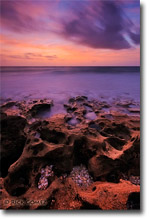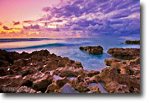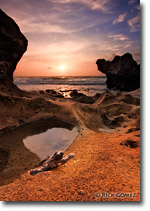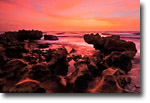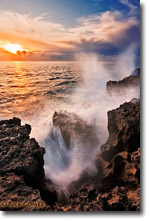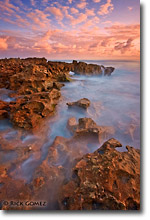Coral Cove Park and the Blowing Rocks Preserve: The Little Sur |
|
The Experience
It's 3:30 a.m. and I wake to the sound of my cell phone's alarm. The smell of the freshly brewed coffee is the start of a day that I have been looking forward to for a while. Today, I visit the Blowing Rocks!
I dread making the phone call to my shooting buddy, Paul, who is definitely not a morning person, but he wants to go anyway. After a couple of rings, a comatose voice answers, "Huh?"
I yell out on the phone, "I'm on my way, get up!"
I kiss my wife good-bye and I'm gone. The excitement that I feel almost makes the coffee unnecessary, yet the 2 hours on the road have me thinking that teleportation would be an awesome creation. Suddenly, the annoying voice of my GPS alerts me that I am nearing my destination. Yes! After the long, dark, boring ride, we're finally here!
As we unload the gear from the car, we hear a thunderous rumble. Then we hear another... and another. We can't help but think that the thunderstorms will probably block our sunrise. But we're here, and we might as well make the best of it. As we make our way over the dunes, we are welcomed by perfect conditions. The first bit of twilight just barely lets us make out the perfectly placed clouds. The thunderous sounds we heard were actually waves crashing violently against the largest rock formations I had ever seen on any Florida coast. At the same time, I also knew that this was not the Blowing Rocks Preserve. These rocks are much smaller. This was, in fact, Coral Cove Park and it was so interesting that we decided to do our shooting here. It just seemed like a sure thing.
Daylight was coming and the sun, although still below the horizon, blessed the sky with shades of magenta, pink, orange and blue. The color of the clouds almost perfectly matches the colors of the rocks. The crashing waves make for a nice fog over the surface of the water in our photos, as we experiment with long exposures. Setting up a tripod can be pretty tricky as the rocks are pitted by hundreds, even thousands of years of erosion. The smooth, reddish-colored rock formations seem to have somewhat of a sandstone appearance, but it is actually anastasia limestone. The waves splash large volumes of water up onto the rocks and as the water recedes, they make an abundance of tiny "waterfalls" which also add a bit of interest to the images we capture. The salt mist creates a natural Orton effect on my ND grad filter, though after a while, it can prove to be a bit too much. All of the crevices, boulders, miniature canyons, blowholes and seashells provide a photographer with so many compositions that it can almost be overwhelming. It's such a great place that it's difficult to stay in just one spot. If only the sun could slow it's ascent, then I could take the time I need to make all these images work. Those are the little things that have me looking forward to my next few trips, though. No two sunrises are ever the same and each trip is a new lesson and a new experience.
The Real Blowing Rocks
On the next trip, we shot sunrise at Coral Cove Park again. It's a summer day with another great sky and the fantastic breeze made it feel like we were still in March. Wispy clouds colored up in a reddish tone and though the waves were still crashing, the tide was lower and the seas were slightly calmer than our last visit. The low tide left behind pools in the craters of the rocks. As I set up the tripod for my next composition, I noticed that one of these pools had trapped a hatchling loggerhead sea turtle. He appeared exhausted, so I took him out of the hole. Paul and I fired off a few shots of the hatchling as he rested. When he seemed to gain enough energy to make his way back toward the ocean, we took him to an area without rocks and set him free at the shoreline. I sure hope he made it.
The sun finally made its way over the horizon, and after wiping down our camera gear with rags dampened with fresh water, we decided to take the 1.25-mile hike up the beach to the Blowing Rocks Preserve. This hike looks much easier than it is. Loosely packed sand and heavy camera gear make the short hike feel like it was over 3 miles uphill. With our calves aching and my lower back in a knot, we finally make it. The preserve has a much easier way to get in, a front door, but they don't open until 9:30 a.m. and we were still an hour away from that time. The tide was not high, but not low either. Though the light was a bit too harsh for my taste, I took the time to scan and photograph the area to scout for possible compositions in the future. At the top of the cliffs, where less erosion takes place, the limestone is a lot more like jagged limestone should be. Walking barefoot was almost worse than the pinnacle rock that I often encounter on my Everglades ventures. Just a little tip: Don't leave your shoes behind!
This area is beautiful! The condominiums that line the coast suddenly cease and for a good stretch of the beach, we are now surrounded by nature. Over the next couple of high-tide visits, I witness the spectacle that gives the area its descriptive name. Strong winds and big waves send water gushing up 40 to 50 feet in the air. Air and water rushing through some of the narrower holes make a barking sound that had me looking for a dog along the beach. Photographer and NPN editor, Richard Bernabe pointed out that the blowholes were working in a sequence as the waves roll in at a slight angle. That was a real show in itself. Although it may be difficult to emphasize this sequence in a photo, the new HD video capable DSLRs would be a great tool to show this off.
Low tide may also present fantastic photo opportunities. A lower tide exposes smaller rocks that would normally be submerged while allowing photographers to shoot from below, showing off the height of the 2 story cliffs in their images. The early morning glow lights up these cliff walls beautifully and this low angle may provide depth to your images. Don't risk it though. If the low tide is not exposing sand, stay away from the cliffs. Rogue waves are common here and they can send you crashing up against the rocks, costing you your gear and possibly your life.
The History
Blowing Rocks is a part of Jupiter Island, which separates the Atlantic Ocean from the Indian River Lagoon. The Blowing Rocks Preserve is now owned and managed by The Nature Conservancy. Although development has taken up much of Jupiter Island, it was actually the island's residents who decided that the area was so beautiful and unique, that it needed protection. They purchased the land and donated it to The Nature Conservancy in 1969. The Nature Conservancy is now working on restoring the 73-acre area of its native plants and protecting this fragile ecosystem.
Residents and visitors both literally and metaphorically walk on eggshells when it comes to coexisting with nature here. This stretch of coast is a very important nest area for three species of sea turtles. Loggerhead, Atlantic Green and the largest of all, the Leatherback sea turtles use this coast for nesting as they have for millennia. During summer months, the sea turtles' struggle for survival is obvious. Hatchlings race toward the water as sea gulls, pelicans, osprey and other native birds try to pick them off. Once in the water, in addition to the birds, all sorts of marine animals now become a threat to the hatchlings. Sometimes the eggs themselves aren't safe. Take a walk down the beach and look for small craters in the sand. You may notice that the craters are surrounded with raccoon prints. Upon closer inspection, you may also notice that some of the broken eggshells still have baby turtles in them that would have otherwise been many days away from hatching. It's a sad situation, but it's nature. This is why sea turtles lay so many eggs. Only one in every hundred makes it through their first year. Humans could make matters worse, but fortunately in this case, the folks at The Nature Conservancy and the caring residents are there to help.
Photography at the Blowing Rocks
This is a fantastic place to get some very unique images, but there are concerns for photographers as well. We are nothing without our photography equipment. Don't let the hazardous conditions have you packing up and leaving early.
Salt water is a killer when it comes to electronics. Crashing waves can wet your gear, causing it to act funny. Even weather-resistant cameras can short out or otherwise malfunction. Make sure you take plenty of lens cloths and rags with you. Keep one handy and make sure the others are kept dry in your camera bag. You will have to change them pretty often. Play it safe and don't give the saltwater a chance to seep into any openings in your electronic gear. Check your lens often as well. Make sure you have no drops on it, which could be a pain in the neck to clone out later.
A tripod is absolutely necessary. Just make sure to rinse it in freshwater when you are done. Coral Cove Park has freshwater showers available near the restroom and playground area.
Do you prefer using ND grads, or blending two to three exposures? I do both, depending on the situation. When shooting at Blowing Rocks Preserve or Coral Cove Park, I find it easier to use a grad. They allow you to catch the action in the water and waves without having to deal with the cumbersome blending process. Blending the images can be tricky with the water movement and splashing waves, especially when using shutter speeds from 1/4 sec. to 2 seconds. Long exposures will completely blur the water, giving it a misty or foggy appearance. Because most of the texture in the water is lost, blending together two long exposures is relatively easy.
Is the weather not what you expected? Make the best of it! Sunrise isn't your only option. If the clouds give way to the sun on the west, with clouds on the east, the colors can be spectacular as sunset approaches. Even if the opposite occurs, look out for a display of anti-crepuscular rays on the east. Even thunderstorms can provide you with a really dramatic sky. With slow enough shutter speeds and a little bit of luck, maybe you'll get some lightning in the image as well.
On your next visit to South Florida, this may be a place of interest to you. It's not what you may expect from the Florida coast, but that's what makes it worthwhile photo shoot. And while it might lack some of the drama of California’s Big Sur, it’s a beautiful place nonetheless. Think of it as “Little Sur!”
Blowing Rocks Preserve is located about half an hour north of West Palm Beach at 574 South Beach Road, Hobe Sound, Florida. The preserve can be contacted at (561) 744-6668.
Comments on NPN nature photography articles? Send them to the editor. NPN members may also log in and leave their comments below.
A South Florida native, Rick Gomez was born and raised in Miami-Dade County. He currently works as a primate keeper and photographer at Monkey Jungle in Miami, where he educates the public about these exotic animals while offering photography workshops in the "Amazonian Rainforest" section of the park. More of Rick's work can be seen at http://wildimages.smugmug.com.
